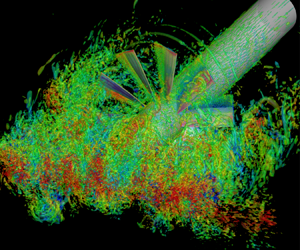Crossref Citations
This article has been cited by the following publications. This list is generated based on data provided by
Crossref.
Zhou, Di
Wang, Kan
and
Wang, Meng
2021.
Computation of Rotor Noise Generation in a Thick Axisymmetric Turbulent Boundary Layer.
Gu, Xinzhong
and
Yao, Jia
2021.
Aeroacoustic prediction for cooling fan using convolution quadrature boundary element method.
The Journal of the Acoustical Society of America,
Vol. 150,
Issue. 3,
p.
1912.
Cianferra, M.
and
Armenio, V.
2021.
Scaling properties of the Ffowcs-Williams and Hawkings equation for complex acoustic source close to a free surface.
Journal of Fluid Mechanics,
Vol. 927,
Issue. ,
Zhang, Chengchun
Sun, Xiaowei
Du, Tianyu
Shen, Chun
Chen, Zhengwu
Liang, Dong
Zhao, Jiale
and
Zhang, Yingchao
2022.
Reduction of noise generated by cylinder-airfoil interaction using grooved structures on the upstream cylinder.
International Journal of Aeroacoustics,
Vol. 21,
Issue. 8,
p.
708.
Zhou, Di
Wang, Kan
and
Wang, Meng
2022.
Computational Analysis of Noise Generation by a Rotor at the Rear of an Axisymmetric Body of Revolution.
Zhou, Zhi-teng
Xu, Zhao-yue
Wang, Shi-zhao
and
He, Guo-wei
2022.
Wall-modeled large-eddy simulation of noise generated by turbulence around an appended axisymmetric body of revolution.
Journal of Hydrodynamics,
Vol. 34,
Issue. 4,
p.
533.
Xiong, Ziying
Rui, Wei
Lu, Linzhang
Zhang, Guoping
and
Huang, Xun
2022.
Experimental investigation of broadband thrust and loading noise from pumpjet due to turbulence ingestion.
Ocean Engineering,
Vol. 255,
Issue. ,
p.
111408.
Wu, Jiafeng
Jiang, Hanbo
Ma, Zhaokai
Chen, Wangqiao
and
Huang, Xun
2022.
Numerical investigation of airfoilrotor interaction at low Reynolds number.
Physics of Fluids,
Vol. 34,
Issue. 2,
Posa, Antonio
Broglia, Riccardo
Felli, Mario
Cianferra, Marta
and
Armenio, Vincenzo
2022.
Hydroacoustic analysis of a marine propeller using large-eddy simulation and acoustic analogy.
Journal of Fluid Mechanics,
Vol. 947,
Issue. ,
Wang, Jinxin
Ishibashi, Kenta
Ikeda, Teruaki
Fujii, Takeo
Nakata, Toshiyuki
and
Liu, Hao
2022.
Morphological effects of leading-edge serrations on the acoustic signatures of mixed flow fan.
Physics of Fluids,
Vol. 34,
Issue. 4,
Wang, Ran
Yu, Longjing
Wei, Chunhua
Ma, Shuai
Zhang, Weiguo
Chen, Zhifei
and
Yu, Liang
2022.
Aerodynamic noise separation of helicopter main and tail rotors using a cascade filter with Vold-Kalman filter and cyclic Wiener filter.
Applied Acoustics,
Vol. 192,
Issue. ,
p.
108751.
Zhou, Di
and
Wang, Meng
2023.
Computational Analysis of Sound from a Rotor Ingesting a Non-Axisymmetric Turbulent Boundary Layer.
Zhu, Bing
Li, Yue
Xu, Wen-jun
and
Zhang, Wei
2023.
Hydrodynamic characteristics and noise reduction mechanism of a wave leading hydrofoil placed in the wake of a cylinder.
Journal of Hydrodynamics,
Vol. 35,
Issue. 6,
p.
1089.
Wu, Jiafeng
Yangzhou, Jianyun
Ma, Zhaokai
and
Huang, Xun
2023.
Numerical study of rotor unsteady forces and noise due to ingestion of grid-generated turbulence.
Physics of Fluids,
Vol. 35,
Issue. 1,
Huang, Xun
2023.
Convolution for Haystacking in Turbulence-Ingesting Rotor Noise.
AIAA Journal,
Vol. 61,
Issue. 2,
p.
950.
Yangzhou, Jianyun
Wu, Jiafeng
Ma, Zhaokai
and
Huang, Xun
2023.
Aeroacoustic sources analysis of wake-ingesting propeller noise.
Journal of Fluid Mechanics,
Vol. 962,
Issue. ,
Zhou, Di
Wang, Kan
and
Wang, Meng
2024.
Rotor aeroacoustic response to an axisymmetric turbulent boundary layer.
Journal of Fluid Mechanics,
Vol. 981,
Issue. ,
Wang, Ruichen
Ma, Zhaokai
and
Huang, Xun
2024.
Experimental investigation of ducted fan noise control by turbulence grids insertion between propellers and struts.
Physics of Fluids,
Vol. 36,
Issue. 8,
Salet, Augustin
Casalino, Damiano
and
Gonzalez-Martino, Ignacio
2024.
Noise Predictions of a Rotor Ingesting a Turbulent Boundary Layer at Different Operating Conditions.
Wu, Han
Li, Yuhong
Zhang, Xin
Zhong, Siyang
and
Huang, Xun
2024.
Experimental study of the turbulence ingestion noise of rotor blades.
Physical Review Fluids,
Vol. 9,
Issue. 4,
